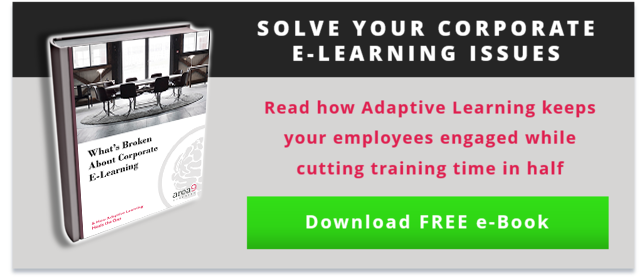Which is better: e-learning or classroom instruction? It’s a question Learning and Development (L&D) has been asking since e-learning first came on the scene two decades ago. We’re ready for an answer. So let’s break down both options.
Learning leaders want just-in-time learning: learning done when the learner needs it. And they want it at the right cost because Learning and Development might not get the largest slice of the budgetary pie. E-learning is the only way to achieve this.
On the other hand, while arguably affordable, convenient, and accessible, a generally accepted industry narrative is that e-learning - and its one-size-fits-all approach - doesn’t have the same level of efficacy as classroom instruction. Furthermore, impact is better measured in a classroom - that is, if we measure impact by bums in seats or passing score metrics.
Finally (and often perceived as the nail in e-learning’s coffin) there’s the criticism that e-learning lacks the human aspect. Good facilitators inspire, motivate, encourage, and support. They get people excited about learning.
But is it possible to have it all?: Learning that meets the needs of the learner, learning that is motivating, exciting, and engaging, with interactive content, and on a budget?
Adaptive Learning Is the Answer to the Classroom Versus E-Learning Question
It is possible to engage learners to the same degree a facilitator would with an e-learning budget - with the right kind of software. But that software must be engaging, personalized, and make learners feel like they’re actually learning something. That software must be adaptive.
Adaptive Learning achieves engaged learning because it adapts to the needs of every learner. It understands the learner’s behavior, their way of learning, and their confidence level much like an in-class facilitator would. The result is learners can feel the software adapting to them and it provides a way to measure impact.
As the software interacts with the learner (i.e.poses questions (probes) for the learner to answer) the Adaptive Learning platform records the learner’s answers to demonstrate knowledge, and records the learner’s confidence in their answers. If learners do not display confidence in the content, the platform provides the learner with resources. The learning goal of Adaptive Learning is to always reach mastery of the content.
The Adaptive Learning data provides the business with the ability to track impact on a micro-level: how each learner performs, which helps the business identify who needs help or who might be in need of more of a challenge; and on a macro-level: how teams, departments, or the company performs as a whole, which determines where problem areas in learning might lie.
The interactive content in Adaptive Learning brings the best parts of in-class facilitators and e-learning to your employees. Here are some other benefits Adaptive Learning can have for your business:









